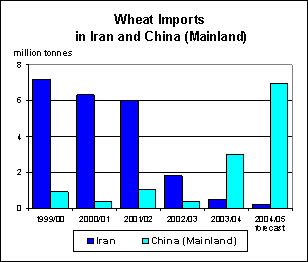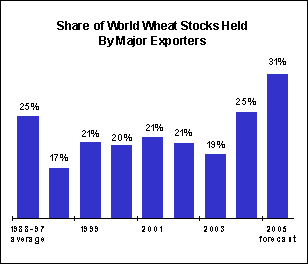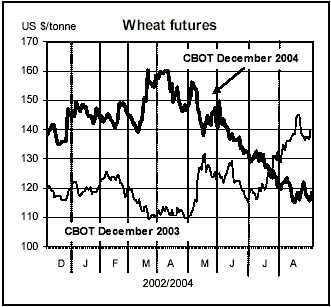


 |
 |
|
 |
||
|
|
||
|
|
|
| food outlook | |
| No. 3 | Rome, September 2004 |
|
WheatWheat production
Source: FAO. Note: Totals computed from unrounded data.
As of mid-September, with about 75 percent of the global wheat crops already harvested, firmer estimates of production are available from many major producing countries. FAO’s forecast for world wheat production in 2004 now stands at 613.2 million tonnes, 18 million tonnes more than the previous forecast in June, and 53 million tonnes more than in 2003. At the world level, a huge recovery in output in Europe has overshadowed most other regional variations, which have been relatively minor in comparison. In Far East Asia, generally good growing conditions characterized the season just ended in the main producing countries. In China, record yields pushed output up 5 percent from last year to 91 million tonnes, despite a continuation of the downward trend in plantings. The crop in India, harvested in April/May, is officially estimated at almost 73 million tonnes, about 12 percent up from 2003, reflecting a significant increase in plantings and a recovery of yields. A larger crop is also estimated in Pakistan, reflecting good rainfall during the important development stages. In the Asian CIS countries, the wheat harvest is nearly complete with the exception of northern Kazakhstan. The aggregate output for the subregion is estimated at about 22 million tonnes, nearly 1.4 million tonnes down on last year’s good harvest. The decline in output is mainly in Kazakhstan due to adverse weather conditions in early spring. In the Asian Near East, results of the recently completed harvest are good in the major producers Turkey and in the Islamic Republic of Iran. However, drought has adversely affected output in Afghanistan, where the crop is estimated at just 2.3 million tonnes, about half the record level of last year. In North Africa, harvesting of the 2004 wheat crop was nearly complete as of late August. An earlier potential threat of a Desert Locust infestation was avoided by a large-scale control operation. Thus, the full potential of this year’s increased plantings, better input supply and favourable weather was realized and aggregate wheat output in the subregion is provisionally estimated at a record 17.3 million tonnes, 38 percent higher than the average for the previous five years. In Egypt and Morocco, the largest wheat producers in the subregion, wheat production is forecast at about 7 million tonnes and 5.5 million tonnes respectively. In eastern Africa, prospects for the 2004 wheat crop in Kenya and Ethiopia are uncertain due to inadequate rains at the beginning of the season in main growing areas. Some late rains have subsequently improved prospects but the final outcome could still depend greatly on the extent of rains in the next few weeks. In southern Africa, overall prospects for the 2004 wheat crop, to be harvested from October/November, are favourable, reflecting a recovery from the drought-affected 2003 season and improved prices of the commodity on the international market at planting time, which resulted in a significant increase in the area planted. In South Africa, which accounts for about 85 percent of the subregion’s aggregate production, the first official production estimates indicate an increase in production by almost a third over the previous year to an average level of about 2 million tonnes. In Central America and the Caribbean, the 2004 wheat crop in Mexico has been gathered and output is estimated to be about 17 percent down from the previous year at 2.4 million tonnes. Reduced water supplies for irrigation led to a sharp drop in plantings. In South America, planting of the 2004 winter wheat crop has been virtually completed in Argentina, Chile, Paraguay and Uruguay, while in southern producing states of Brazil crops are already in the vegetative/heading phase. The aggregate planted area of the subregion is estimated to be up by about 5 percent from last year, which could lead to a record output of 24.3 million tonnes. In North America, prospects for the spring wheat crop have improved somewhat since the previous report, raising the forecast for the 2004 aggregate wheat output. Nevertheless, this year’s aggregate crop would still be some 9 percent down compared to last year due to reduced plantings. In Canada, weather conditions have remained generally favourable in the main wheat producing areas, and latest forecasts point to a 4 percent increase in output this year to 24.6 million tonnes. In Europe, the bulk of the 2004 wheat crops have already been gathered in central and southern parts, and latest information confirms a sharp recovery in output throughout the region from the drought-reduced levels in 2003. The forecast of aggregate output in the EU-25 now stands at 129 million tonnes, having been raised since June following reports of better yields at harvest than had been expected earlier. The same holds true for the Balkan countries, where a recovery from the devastating drought last year has superseded earlier expectations and aggregate output could be the best of recent years. In the European CIS countries, the wheat harvest was progressing well ahead of schedule in August despite some rains during the initial stages. The aggregate output in the subregion is forecast at 60.4 million tonnes, about 54 percent up on last year’s poor level, of which some 42 million tonnes is expected in the Russian Federation and 16.5 million tonnes in Ukraine. This increase reflects not only increased yields because of better moisture supplies compared to the drought in 2003 but also increased plantings and a mild winter, which led to significantly lower winterkill. In Oceania, less than optimal rainfall continues to hamper development of the winter wheat crop in Australia after a promising start to the season. Rainfall has been particularly sparse in the important producing state of New South Wales. The latest official forecast in September foresees production at just over 22 million tonnes, 3 million tonnes down from last year because of poorer yield prospects.
FAO’s forecast for world trade in wheat1/ in 2004/05 (July/June) has been raised to 98.5 million tones, 500 000 tonnes more than expected in June but still sharply below the previous season’s level, owing to reduced demand because of higher wheat production in several importing countries. Wheat imports by the developed countries are forecast to fall to around 19 million tonnes, as a result of a strong recovery in production, especially in the EU-25, Romania, the Russian Federation and Ukraine. By contrast, aggregate imports by the developing countries are forecast to increase by 6 million tonnes from the previous season, to 79 million tonnes. Higher wheat imports by China account for most of the anticipated growth in this season’s imports by the developing countries. Wheat purchases by China (mainland) are currently forecast at 7 million tonnes, up almost 4 million tonnes from 2003/04. Although China’s wheat production is likely to expand for the first time in 5 years, low carryover stocks and strong demand for milling quality wheat could still give rise to much higher imports than in the previous season. Among other countries, wheat imports by Mexico and Tunisia are also forecast to increase as a result of smaller production. In addition, the forecast for imports by Pakistan has been raised by 500 000 tonnes since the previous report, reflecting the recent decision by the Government to allow wheat imports of 1 million tonnes for stock replenishment. By contrast, wheat imports by the Islamic Republic of Iran, traditionally among the world’s largest wheat importers (see chart), may fall to a record low of only 200 000 tonnes in view of another bumper crop.  Regarding exports, wheat shipments from the United States are forecast to fall in view of lower production but export prospects for other major exporting countries remain positive. Total exports by the EU-25 are tentatively put at 14 million tonnes, up sharply from the previous season. The exportable wheat surplus in the EU is seen to be even higher than this but with a recent slide in world wheat prices and a prevailing strong Euro (against the US Dollar), the EU is facing strong competition in world markets. Larger crops are likely to boost sales also from the Russian Federation and Ukraine but exports from India are likely to fall drastically this season. India emerged as a large exporter in recent years but as stocks fall and domestic supplies become tighter, shipments have also slowed down considerably. India’s wheat exports are forecast to reach only 1 million tonnes, down 4 million tonnes from the estimated exports in 2003/04.
The forecast for world wheat utilization in 2004/05 has been raised slightly since the previous report, to 609 million tonnes, up 1.7 percent from 2003/04 and close to the 10-year trend. Most of the expansion is expected in the developed countries, driven by higher feed use following a rebound in production and larger feed wheat availabilities. World feed use of wheat is forecast to rise to 108 million tonnes, up 6 million tonnes from the reduced level in 2003/04. A recovery in wheat supplies is expected to encourage higher feed use of wheat instead of less abundant coarse grains. The developed countries account for roughly 93 million tonnes, or 86 percent, of total wheat feed use, of which the leading consumer is the EU-25, where this season’s feed use is anticipated to increase to 55 million tonnes in view of a sharp rise in internal supplies. Feed use of wheat in Asia is also seen to rise this season, to compensate for reduced maize utilization due to lower availabilities. World wheat use for human consumption is forecast to increase slightly, to 432 million tonnes with the largest increase in the developing countries. In China, however, a gradual change in consumption patterns away from wheat is expected to continue, resulting in a further small decline in wheat consumption, in per caput terms, also in 2004/5.
As a result of a more favourable outlook for global production, the prospects for stocks have also improved. The forecast for world wheat stocks for crop years ending in 2005 has been raised significantly since the previous report in June to 160 million tonnes, which would be slightly up from their opening levels and represents the first increase in 5 years. The biggest growth is likely to occur in countries where this year’s production recovery is strongest, especially in Europe.  Among the major exporters, wheat stocks in the EU-25 are now forecast to jump to 17 million tonnes. In the United States, wheat production is forecast to decline but because of weaker export prospects, stocks are likely to increase slightly. Overall, total wheat inventories in major exporting countries are forecast to reach 49 million tonnes, up 7 million tonnes from their reduced opening levels and 8 million tonnes more than was reported in June. As a result, the global share of major exporters’ wheat stocks by the close of seasons in 2005 is now put at 31 percent, which represents a considerable improvement from only 25 percent at the start of the season. Among other countries, in China, even with a rise in production and the likelihood of a sharp increase in imports, wheat stocks could still decline by around 8 million tonnes, to 48 million tonnes, which would be lowest level since 1982. Also in India, this year’s anticipated increase in domestic production coupled with a cut in its exports could help to limit the decline in its inventories which, at 16.5 million tonnes, would still be 1 million tonnes smaller than in the previous season. By contrast, wheat inventories are forecast to increase sharply in the CIS, up 3 million tonnes in aggregate, because of a rebound in production in several countries; most notably in the Russian Federation and Ukraine.
In view of good crop prospects which are expected to result in a strong rebound in world wheat production this year, international wheat prices remained under downward pressure. In August, the price of US wheat No. 2 (HRW, fob) averaged US$146 per tonne, down US$21 since May and also US$9 below the corresponding period last year. The increase in this season’s wheat supplies coincides with a likely contraction in world import demand by several major wheat importing countries that had bumper domestic crops and consequently have reduced import needs. Combined with the usual seasonal harvest pressure at this time of the year, freight rates remain high (in spite of recent retreats), which also contributed to a more bearish export sentiment during the past few weeks. Against this background, international wheat prices seem unlikely to receive any significant positive support also in the coming months. Since the start of the marketing season, wheat futures have remained persistently below the previous year’s values and by late August, the December wheat futures contracts at the Chicago Board of Trade (CBOT) were quoted at US$119 per tonne, a drop of almost US$26 since May.   1. including wheat flour in grain equivalent. |
||||||||||||||||||||||||||||||||||||||||||||||||||||||||||||||||||||||||||||||||||||||||||||||||||||||||||||||